When dressing your baby for winter, you should layer them up, starting with a snug onesie. Add long-sleeve shirts and a warm jacket, but make sure it's not too bulky for car seats. Don't forget mittens and a hat to keep their extremities warm. Regularly check for any signs of cold or overheating. Always opt for waterproof materials if they're playing in the snow. Discover more essential tips to keep your little one cozy and safe!
Key Takeaways
- Dress your baby in layers, starting with a snug onesie, and add insulating and waterproof outer layers as needed.
- Choose breathable fabrics to help regulate your baby's temperature and avoid overheating.
- Use warm mittens, booties, and a snug hat to protect extremities from the cold.
- Ensure outerwear fits well with car seat harnesses to maintain safety during travel.
- Regularly monitor your baby's comfort and skin condition for signs of cold exposure.
Dressing Your Baby in Layers
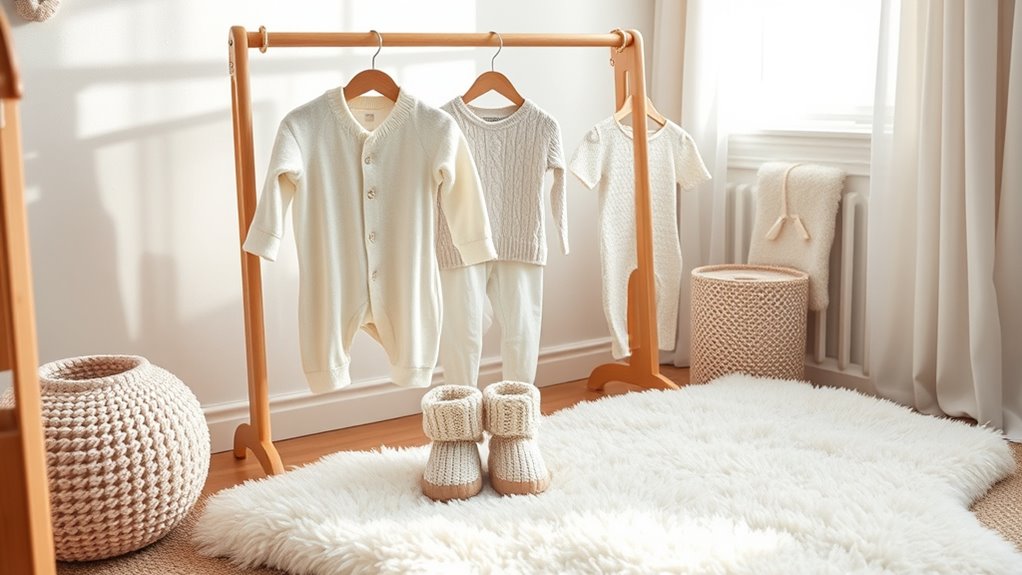
When dressing your baby for winter, it's essential to layer their clothing effectively to keep them warm and comfortable.
Start with a snug onesie as the base layer and add long-sleeve shirts, sweaters, and jackets as needed. This way, you can easily adjust layers as temperatures change. Proper financial planning can help parents budget for necessary winter clothing. Additionally, consider investing in safe sleep environments to ensure your baby remains comfortable during naps and nighttime. Engaging in regular physical activity can also support your baby's overall development and health during the colder months. A well-structured budget can help manage these savings goals for winter necessities.
Always dress your baby in an extra layer compared to what you'd wear in the same cold weather conditions, since babies lose heat faster.
Avoid bulky clothing in car seats; instead, opt for a light jacket and cover your baby with a blanket after securing them.
Regularly monitor your baby's comfort to guarantee they're neither overheated nor too cold, adjusting layers accordingly for a cozy, safe experience. Proper nutrition is also important for maintaining your baby's overall health during the winter months.
Covering the Extremities
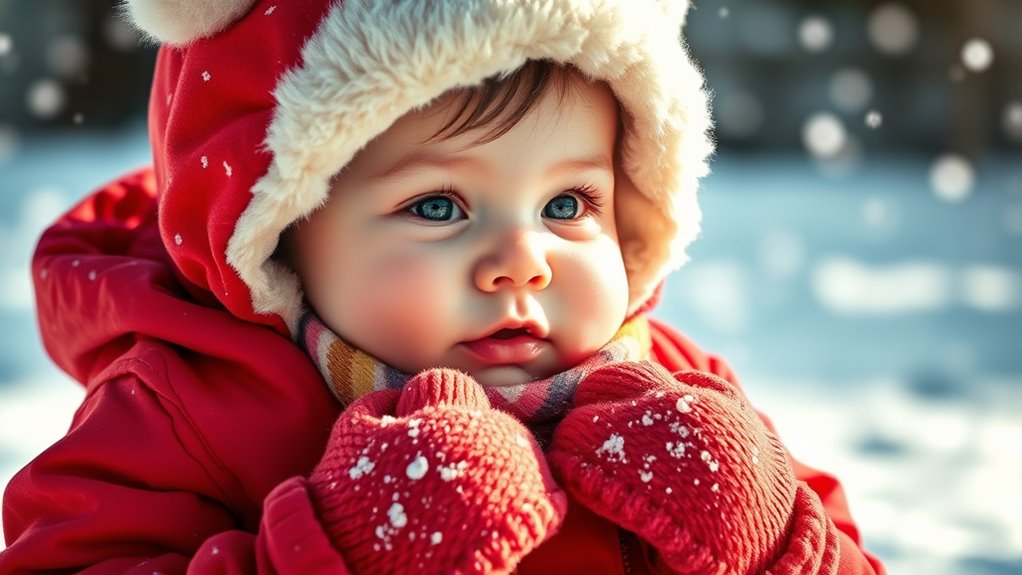
Covering your baby's extremities is essential for keeping them warm during winter. Babies lose heat rapidly through their fingers, toes, and ears, making protection against the cold vital.
Keeping your baby's extremities covered is crucial in winter, as they lose heat quickly through their fingers, toes, and ears.
Dress your baby in warm mittens or gloves that fit snugly, so they stay on and don't get lost. Don't forget warm booties or thick socks to insulate their feet from chilly surfaces, especially when you're outdoors. Multi-functional products can also help parents choose clothing layers that keep their baby warm without adding excessive bulk. Additionally, consider using portable camping toilets for family outings, as they provide comfort and convenience while ensuring your baby stays warm during winter trips. Introducing beetroot puree into their diet can also provide essential nutrients that support their overall health during the colder months. Regular maintenance of energy-efficient appliances can also ease the burden of home heating costs during winter.
A snug-fitting hat or beanie is also important for retaining heat and safeguarding their head and ears from harsh winter conditions.
Regularly check your baby's hands, feet, and face for any signs of coldness, like paleness or shivering, ensuring they stay cozy and warm throughout the winter season. Additionally, it's crucial to monitor their comfort and warmth as increased smartphone usage among seniors has shown that awareness of temperature can significantly affect well-being.
Checking for Overheating
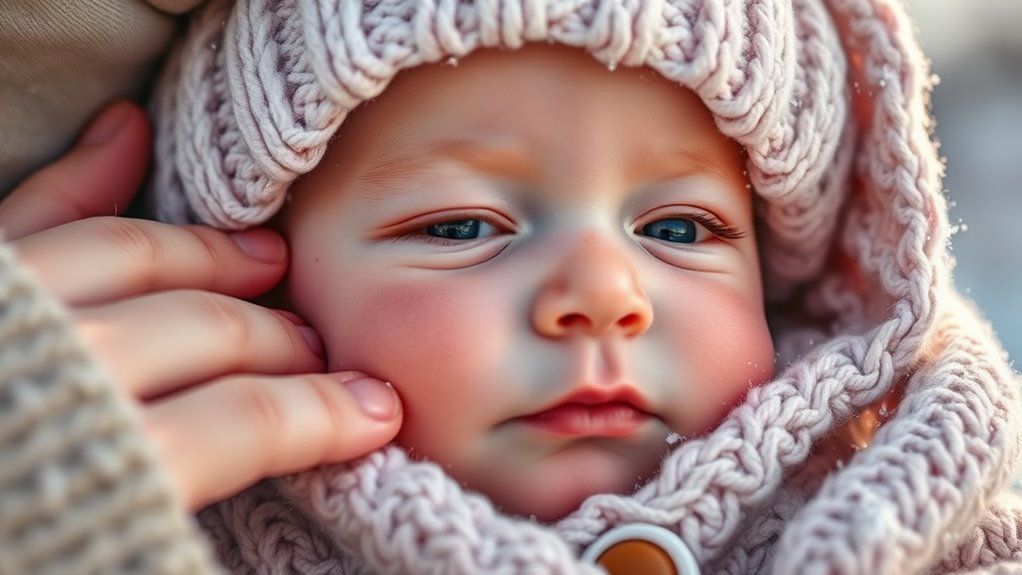
How can you guarantee your baby stays warm without overheating? To dress your newborn appropriately, use layers of clothing, allowing you to adjust easily. Aim for one to two layers for sleep and keep an eye on your baby's body temperature.
Ideal indoor temperatures should range from 68-72°F to guarantee comfort. Always check for signs of discomfort, like sweating, moist hair, rapid breathing, or flushed cheeks, indicating your baby might be too warm.
If you notice any signs of overheating, remove additional layers immediately to keep your baby warm and safe. Remember, overheating can increase the risk of injury, including Sudden Infant Death Syndrome (SIDS), so monitoring your baby's comfort is essential during winter months.
Using Waterproof Materials for Snow Play
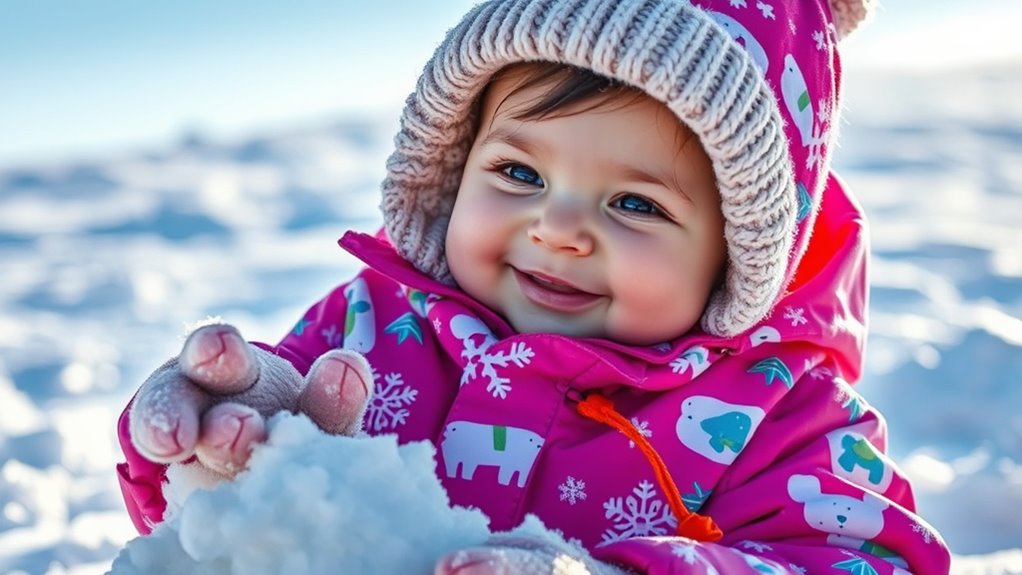
Keeping your baby warm and dry during winter snow play is just as important as monitoring for overheating indoors. Waterproof baby snowsuits are essential for making certain your little one stays dry while enjoying the snow.
These suits provide protection against cold and wet conditions, allowing moisture to escape while maintaining warmth. When you choose a waterproof suit, make sure it fits well without restricting movement; this guarantees your baby can safely explore and play.
Comfort is key, as a snug fit prevents any discomfort that could lead to cold exposure. Always keep an eye on your baby for signs of discomfort, even in waterproof materials, to ensure their safety during winter activities.
Recognizing Warning Signs of Cold Exposure
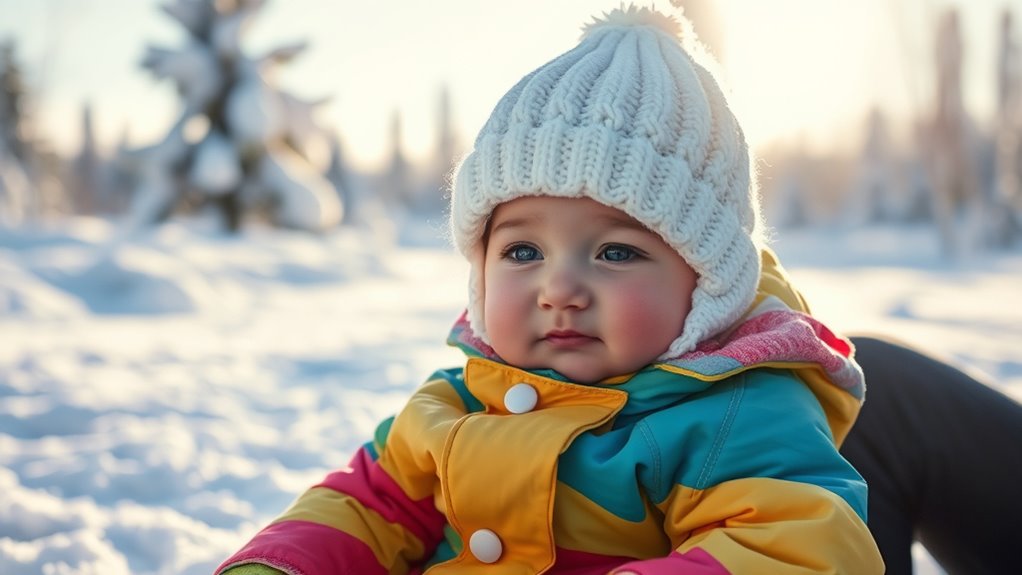
When dressing your baby for winter, it's essential to recognize the warning signs of cold exposure.
Look for symptoms like lethargy, shivering, or pale skin, as these can indicate hypothermia or frostbite.
Keeping a close eye on their temperature and skin condition can help guarantee they stay warm and safe.
Signs of Hypothermia
Recognizing the signs of hypothermia in babies is crucial for their safety during winter months. If you notice cold hands and feet or pale skin, it's time to reassess how you dress your baby.
Make certain to layer clothing effectively to keep your baby's body heat from escaping. Shivering is a clear sign they're too cold and requires immediate warming measures.
Additionally, monitor for symptoms like lethargy or unresponsiveness, which can indicate severe cold exposure.
While you want to keep your baby warm, also watch for overheating signs like sweating or rapid breathing.
Frostbite Indicators
Frostbite can develop quickly in babies exposed to extreme cold, so it's crucial to be vigilant about their skin's condition.
Look for these signs to protect your little one:
- Cold hands and feet: If your baby's extremities feel cold, they may not be warm enough; act fast!
- White or blistery patches: These can appear on their skin, especially fingers, toes, or ears—clear indicators of frostbite.
- Shivering: This tells you your baby is too cold and needs extra layers or warmth.
If you notice lethargy, unresponsiveness, or pale skin, these could be signs of hypothermia.
Regularly checking your baby's skin can help you catch frostbite early, ensuring they stay safe and warm during winter outings.
Monitoring Baby's Temperature
How can you guarantee your baby stays warm during winter outings? Start by monitoring their temperature closely, as babies lose body heat four times faster than adults.
Dress your little one in layers, ensuring they're snug but not too tight. Always cover their head and extremities, since these areas are particularly vulnerable to cold.
Watch for signs of cold exposure like cold hands and feet, pale skin, lethargy, and shivering. If you notice any of these, it's vital to act quickly.
Conversely, be vigilant about overheating—sweating, flushed cheeks, and rapid breathing indicate discomfort. Keeping your baby in a comfortable temperature range is essential, so adjust their layers as needed to maintain safety and warmth.
Essential Tips for Car Seat Safety in Winter
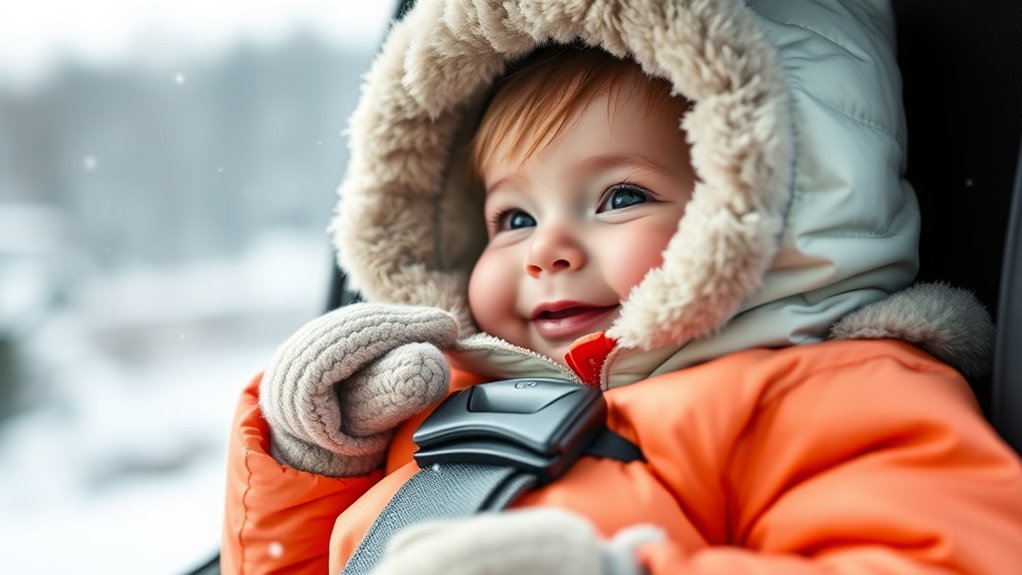
As winter sets in and temperatures drop, guaranteeing your baby's safety in the car becomes even more essential. Here are some key tips to keep in mind when dressing your baby for winter car rides:
- Remove Bulky Outerwear: Always take off heavy jackets or snowsuits before securing your newborn in the car seat; they can compress in an accident.
- Use a Fleece Suit: Dress your baby in a thin, well-fitted fleece suit for warmth, then cover the harness with an extra blanket.
- Choose Proper Car Seat Covers: Ascertain any car seat covers are designed specifically for safety and don't interfere with the harness system.
Frequently Asked Questions
How Should Babies Be Dressed in Winter?
When dressing your baby for winter, layer them in multiple thin layers, adding one more than what you'd wear.
Make certain their extremities—like fingers, toes, and ears—are covered with mittens, booties, and a beanie.
Avoid bulky jackets under car seat harnesses; opt for lighter options and use a blanket for extra warmth.
Always check for signs of overheating and choose breathable, waterproof materials for outdoor play to keep them comfortable and dry.
What to Wear When Baby Wearing in Winter?
Picture a frosty morning, your breath visible in the crisp air as you step outside with your baby nestled against you.
When babywearing in winter, dress your little one in a cozy sleeper secured snugly in the carrier.
If you've got a babywearing coat, drape it over both of you for warmth.
If not, use an extender panel for your coat, ensuring their face stays uncovered and comfortable throughout your adventure.
What Should a Baby Wear in 75 Degrees?
When it's 75°F, you should dress your baby in a single layer of lightweight clothing.
A cotton onesie works well, keeping them cool and comfortable. Make sure the fabric is breathable to help with air circulation.
If you're outdoors, keep them in the shade and use a wide-brimmed hat to protect against the sun.
Always check for signs of overheating, like sweating or flushed cheeks, and adjust their clothing accordingly.
What Should a Baby Wear in 68 Degree Weather?
In 68-degree weather, you'll want your baby to feel cozy without overheating. You can dress them in a long-sleeved onesie paired with lightweight pants.
If it feels a bit chilly, throw on a light sweater or thin cardigan for that perfect layer.
Keep an eye out for signs of overheating—sweaty brows or flushed cheeks mean it's time to adjust.
Breathable fabrics are key to keeping them comfortable all day long!
Conclusion
So, when it comes to dressing your baby for winter, don't just throw on a onesie and call it a day! Layer them up like a little burrito, cover those tiny fingers and toes, and keep a watchful eye for any signs of overheating. Remember, you're not just keeping them warm; you're on a mission to conquer the cold! With a sprinkle of waterproof magic for playtime, you'll turn winter into a cozy adventure for your little snow explorer!









